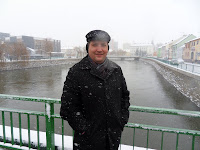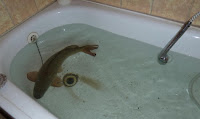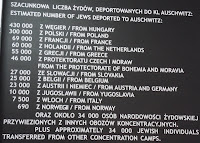 Břeclav is a small border town about 55 km (~34 miles) southeast of Brno.
Břeclav is a small border town about 55 km (~34 miles) southeast of Brno.  It sits on the Dyje River at the Austrian border and is about 10 km from Kúty, Slovakia. It is an important railroad hub between Prague/Brno, Bratislava, Vienna and Poland.
It sits on the Dyje River at the Austrian border and is about 10 km from Kúty, Slovakia. It is an important railroad hub between Prague/Brno, Bratislava, Vienna and Poland.Since it is so close to Austria, this is where a lot of Czechoslovakian citizens risked their lives trying to escape to the West during the days of communism. The town has a population of around 26,000 people. The other day my friend, Aleš, gave me a tour of his hometown.
 In Břeclav, we went to the former Jewish Synagogue that now serves as part of the town museum and is used sometimes for concerts.
In Břeclav, we went to the former Jewish Synagogue that now serves as part of the town museum and is used sometimes for concerts. 
The Neo-Romanesque building, with its Neo-Moorish interior, dates back to 1868. There was an exhibition upstairs about the Jewish community in Břeclav from 1414 until WWII.
 The St. Rochus Chapel in the center of town was built in 1892 in memory of a cholera epidemic.
The St. Rochus Chapel in the center of town was built in 1892 in memory of a cholera epidemic.
St. Mary parish church in Poštorná is a Neo-Gothic church built from 1895-1898 with special bricks from a local factory.
St. Wenceslas parish church is a contemporary church built from 1992-1995. It was built on the spot of a Baroque church that was destroyed during the war.

Here's the town's sugar factory...way back when and today.

 Near Břeclav is the Lednice-Valtice cultural-natural complex which has been a UNESCO World Heritage Site since 1996. At the end of the 19th century, the House of Liechtenstein transformed the local area into a landscape park with a chateau in Valtnice and another in Lednice. Between the two are various pavilions, such as the Reistna Colonnade.
Near Břeclav is the Lednice-Valtice cultural-natural complex which has been a UNESCO World Heritage Site since 1996. At the end of the 19th century, the House of Liechtenstein transformed the local area into a landscape park with a chateau in Valtnice and another in Lednice. Between the two are various pavilions, such as the Reistna Colonnade. During the Spring and Summer it is very popular to rent bicycles and ride between the two. I had a nice time seeing what I could but with the limited amount of daylight I could only see enough to know that I have to go back in the Spring. So when the weather warms up I'll make it back to Břeclav, Lednice and Valtice again.
During the Spring and Summer it is very popular to rent bicycles and ride between the two. I had a nice time seeing what I could but with the limited amount of daylight I could only see enough to know that I have to go back in the Spring. So when the weather warms up I'll make it back to Břeclav, Lednice and Valtice again.Update: This is my 300th post since starting this blog. Wow!!!







































